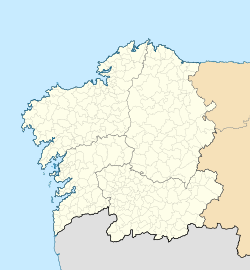Roman Walls of Lugo
Appearance
| UNESCO World Heritage Site | |
|---|---|
 | |
| Location | Lugo, Galicia, Spain |
| Criteria | Cultural: (iv) |
| Reference | 987 |
| Inscription | 2000 (24th Session) |
| Area | 1.68 ha (4.2 acres) |
| Buffer zone | 59.88 ha (148.0 acres) |
| Coordinates | 43°00′40″N 7°33′12″W / 43.0111°N 7.5533°W |
The Roman Walls of Lugo (Spanish, Galician: Muralla Romana de Lugo) were constructed in the 3rd century AD. The walls were created as late Roman Empire fortifications. They are still largely intact today. They stretch over 2 kilometres (1.2 mi) around the historic centre of Lugo in Galicia (Spain). Located on a hilltop the walls have a wide ditch directly in front of them.[1] The walls average about 10 metres (33 ft) in height and are up to 8 metres (26 ft) thick.[1] At the front of the wall there are a series of semicircular towers up to 13 metres (43 ft) in diameter.[1] The walls are constructed of schist from the local area.[2] The walls have been declared a World Heritage site.[2]
Images
[change | change source]Wikimedia Commons has media related to Ancient Roman walls of Lugo.
-
Map of the walls showing the location of the 10 gates
-
The Porta de San Pedro, one of the five original Roman gates
-
Walkway over the walls
References
[change | change source]- ↑ 1.0 1.1 1.2 Simon Esmonde Cleary; A. Simon Esmonde Cleary, The Roman West, AD 200-500: An Archaeological Study (Cambridge: Cambridge University Press, 2013), pp. 127–28
- ↑ 2.0 2.1 Helen Partington; Dorothy Stannard; Brian Bell, Spain (Singapore: APA Productions; Maspeth, NY: Langenscheidt Pub., 2003), p. 324





